
Kea DHCP
(Part 1 - DHCP introduction)
Carsten Strotmann and the ISC Kea Team
Created: 2020-09-17 Thu 17:45
All content © 2020 Internet Systems Consortium, Inc.
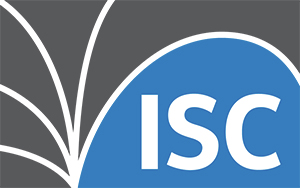

Welcome
Welcome to part one of our webinar series "the Kea DHCP Server"
All content © 2020 Internet Systems Consortium, Inc.


In this Webinar
- a short history of DHCP
- Basics of DHCPv4
- What is different in DHCPv6
- References
All content © 2020 Internet Systems Consortium, Inc.


About DHCP
- DHCP is short for Dynamic Host Configuration Protocol
All content © 2020 Internet Systems Consortium, Inc.


Short history of DHCP (including ISC-DHCP and Kea)

All content © 2020 Internet Systems Consortium, Inc.


DHCPv4 overview
All content © 2020 Internet Systems Consortium, Inc.


DHCPv4 overview (1/2)
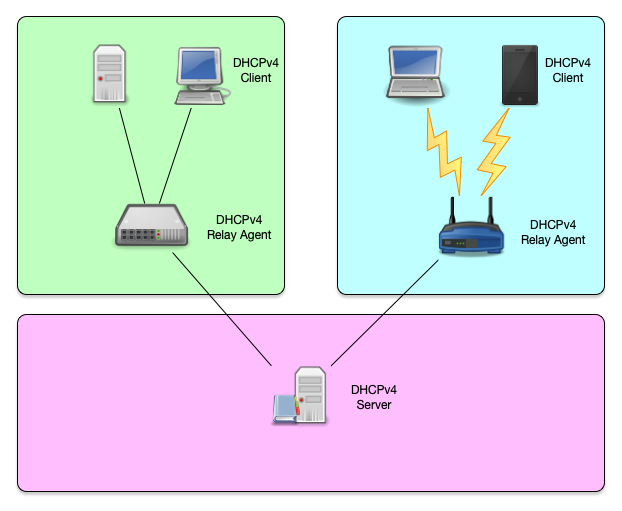
All content © 2020 Internet Systems Consortium, Inc.


DHCPv4 overview (2/2)
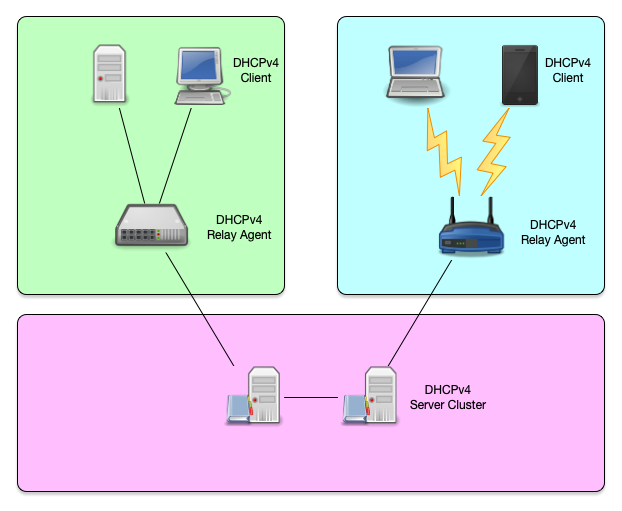
All content © 2020 Internet Systems Consortium, Inc.


DHCPv4 protocol
- the DHCPv4 protocol uses UDP broadcast und (in some situations)
unicast
- the DHCPv4 server or relay agents listen on port 67
- a DHCPv4 client listens on port 68 for messages from a server or relay agent
- the initial request from a client requires layer 2 (Ethernet) communication
All content © 2020 Internet Systems Consortium, Inc.


DHCPv4 Lease concept
All content © 2020 Internet Systems Consortium, Inc.


DHCPv4 Lease (1/3)
- when using the DHCP protocol, a client can never keep an IP Address
forever
- each IP Address given out by a DHCP server has a "lease" time
- this is the time in seconds that the client is allowed to use the IP Address
All content © 2020 Internet Systems Consortium, Inc.


DHCPv4 Lease (2/3)
- the "lease" time is delivered in an DHCP option
- it is a 32bit value
- the maximum lease time is $FFFFFFFE (= 4294967294 seconds or ~136 years)
- a lease time of $FFFFFFFF indicates an infinite lease
All content © 2020 Internet Systems Consortium, Inc.


DHCPv4 Lease (3/3)
- according to the RFC, a DHCP server must store the lease
information to permanent storage before confirming the IP address
to a client
- this can be a performance bottleneck on a DHCP server
- we will discuss the various options in one of the following webinars
All content © 2020 Internet Systems Consortium, Inc.


DHCP Clients, Relays and Server
- because a client machine without IP address can only communicate on the local link, the base DHCPv4 protocol is "link-local" only
- DHCPv4 relay-agents can be used to forward DHCPv4 requests to
centralised DHCPv4 server
- DHCP relay-agents are often found in network equipment (e.g. router)
- dedicated "software based" relay-agents are available

All content © 2020 Internet Systems Consortium, Inc.


DHCP messages and client server communication
DHCPDISCOVER(client asks: is there a DHCP server that can give me an address)DHCPOFFER(DHCP server offers an address to the client)DHCPREQUEST(client requests the IP address offered by the server)DHCPACK(server marks the IP address as leased and confirms that transaction)
All content © 2020 Internet Systems Consortium, Inc.


DHCP messages (1)
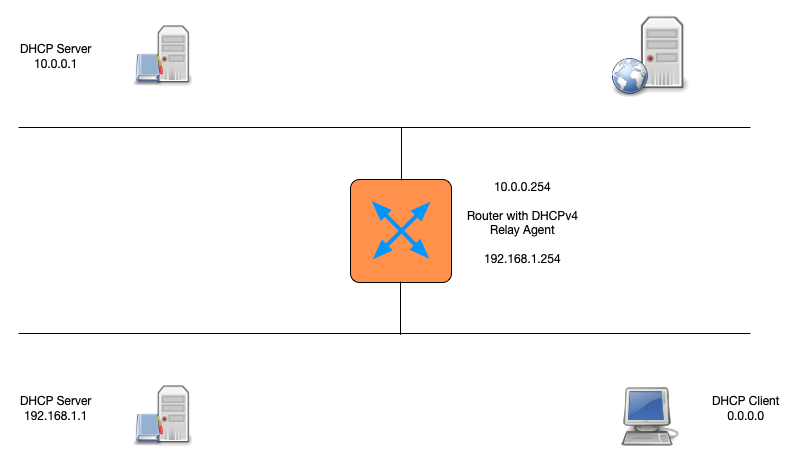
All content © 2020 Internet Systems Consortium, Inc.


DHCP messages (2)
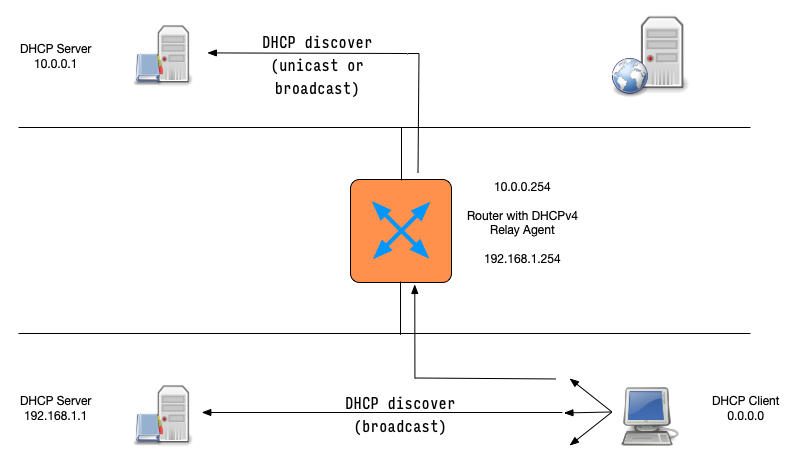
All content © 2020 Internet Systems Consortium, Inc.


DHCP messages (3)
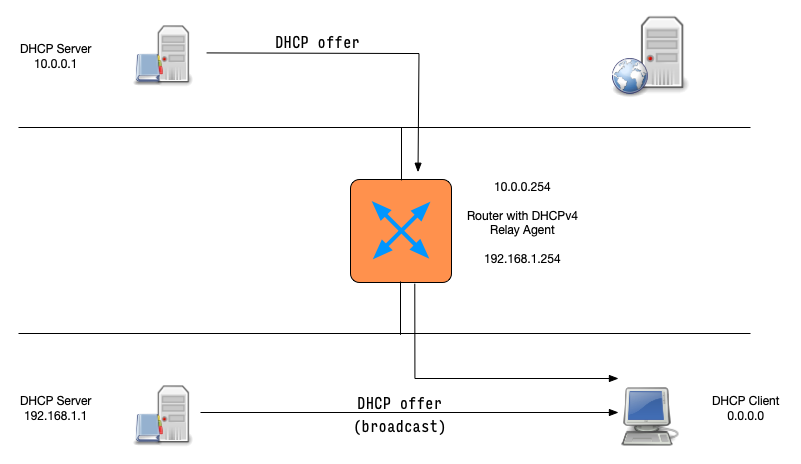
All content © 2020 Internet Systems Consortium, Inc.


DHCP messages (4)
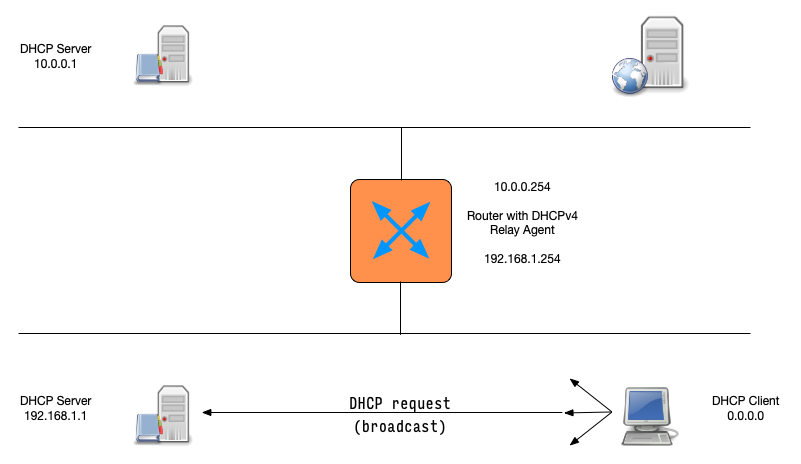
All content © 2020 Internet Systems Consortium, Inc.


DHCP messages (5)
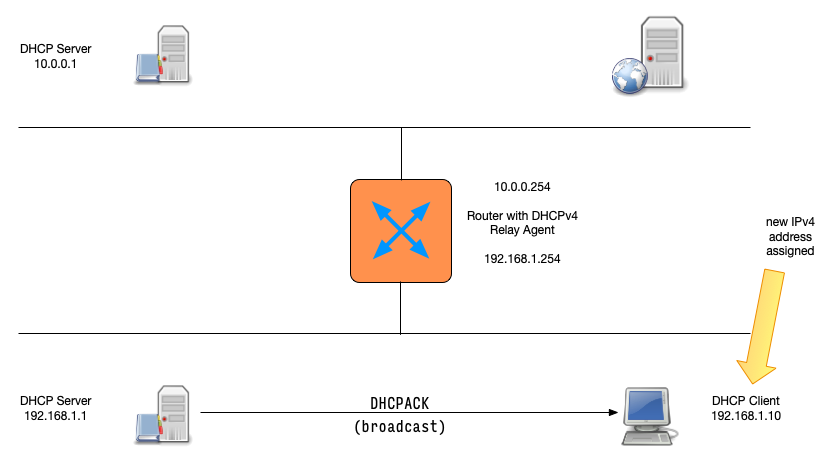
All content © 2020 Internet Systems Consortium, Inc.


DHCPv4 client states
- A DHCP Client goes through a defined number of "states" when
requesting or renewing a lease
INIT-REBOOT,INIT,SELECTING,BOUND,RENEWING,REBINDING
All content © 2020 Internet Systems Consortium, Inc.


without IPv4 address (1/10)

All content © 2020 Internet Systems Consortium, Inc.


without IPv4 address (2/10)
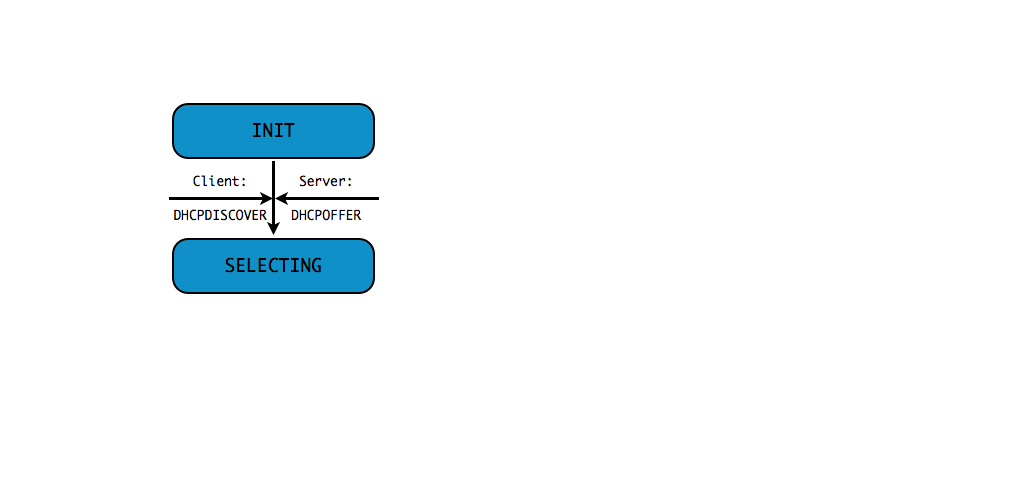
All content © 2020 Internet Systems Consortium, Inc.


without IPv4 address (3/10)
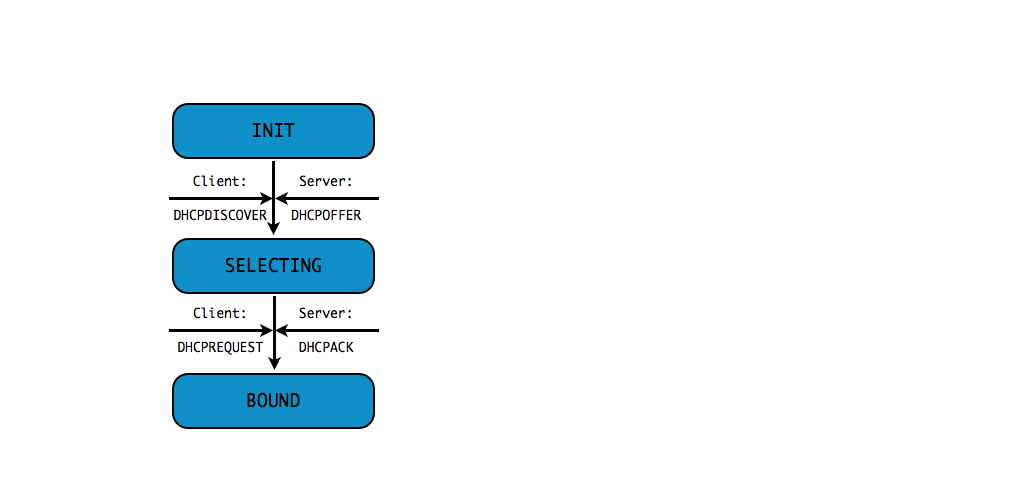
All content © 2020 Internet Systems Consortium, Inc.


without IPv4 address (4/10)
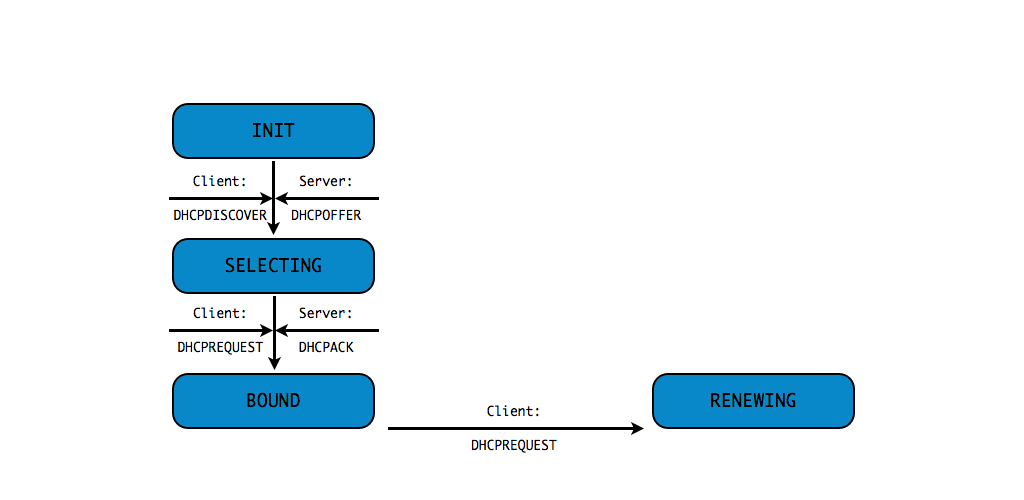
All content © 2020 Internet Systems Consortium, Inc.


without IPv4 address (5/10)
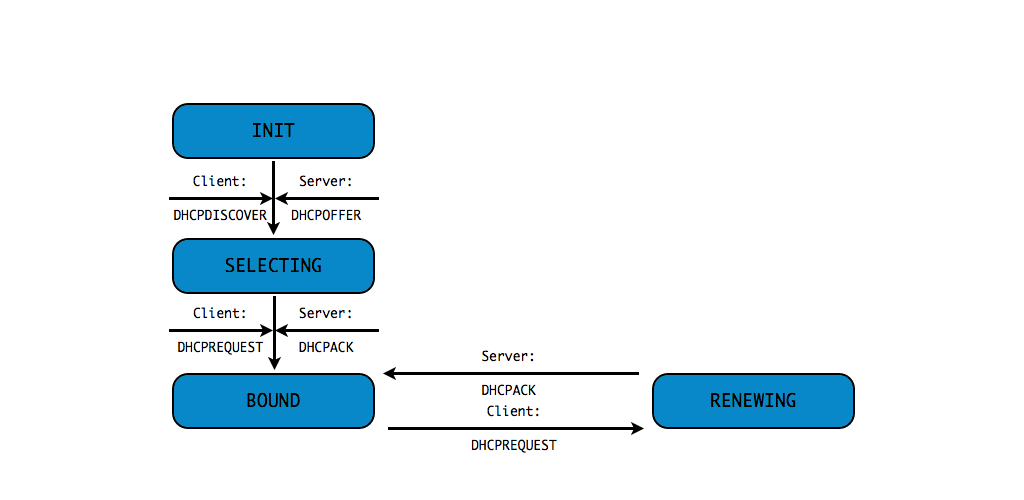
All content © 2020 Internet Systems Consortium, Inc.


without IPv4 address (6/10)
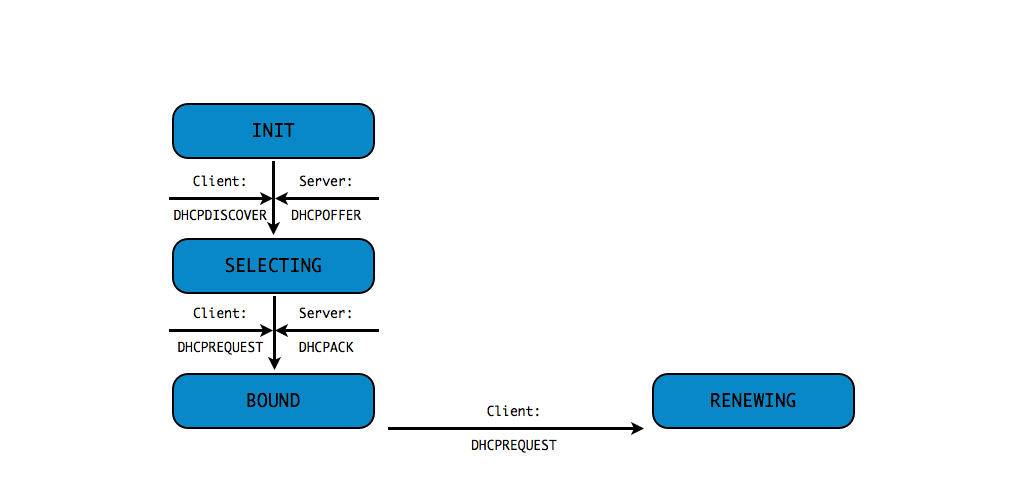
All content © 2020 Internet Systems Consortium, Inc.


without IPv4 address (7/10)
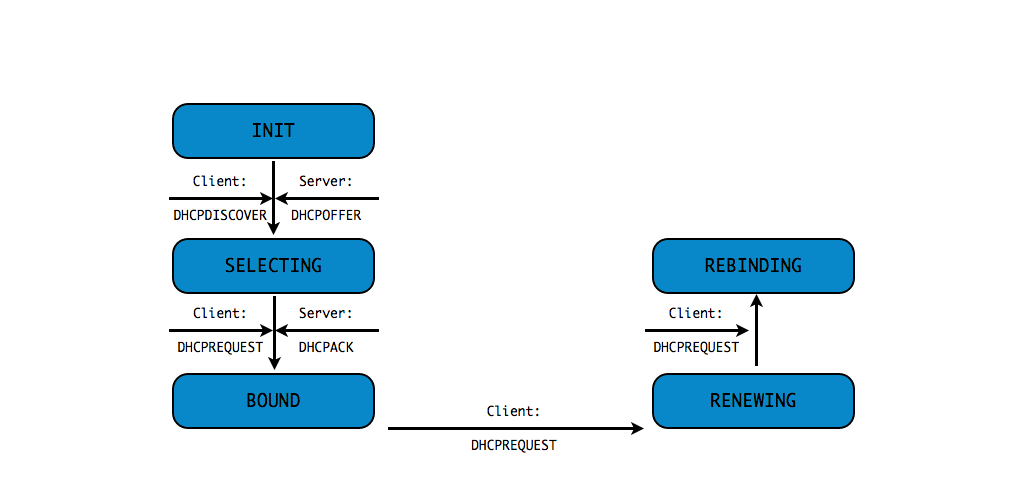
All content © 2020 Internet Systems Consortium, Inc.


without IPv4 address (8/10)
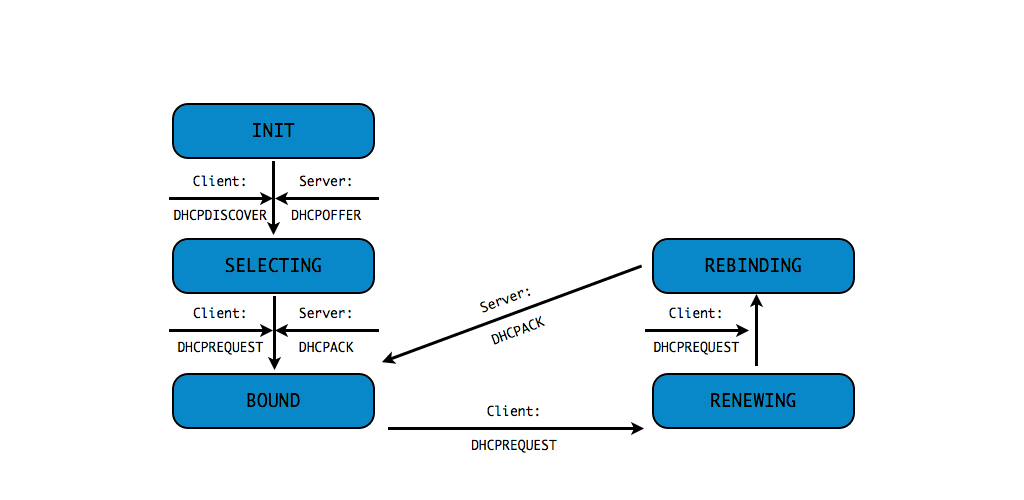
All content © 2020 Internet Systems Consortium, Inc.


without IPv4 address (9/10)
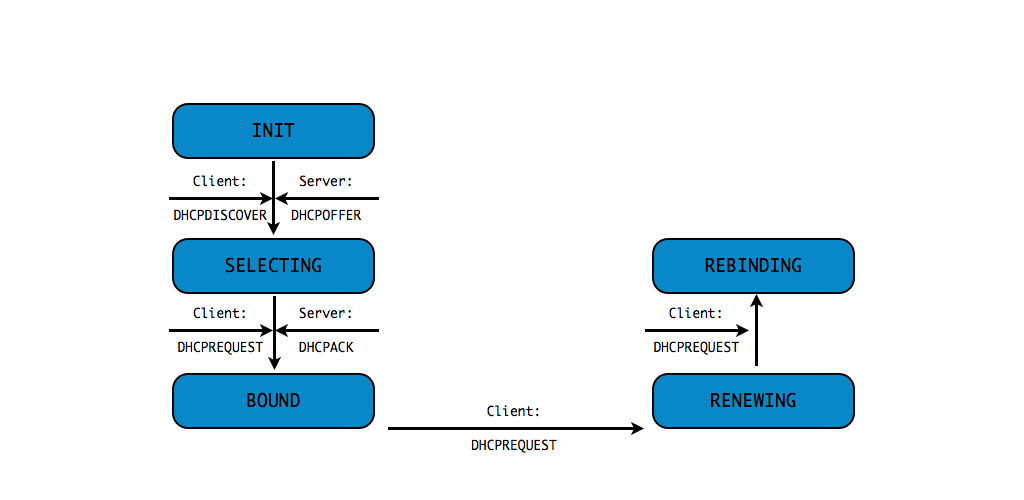
All content © 2020 Internet Systems Consortium, Inc.


without IPv4 address (10/10)
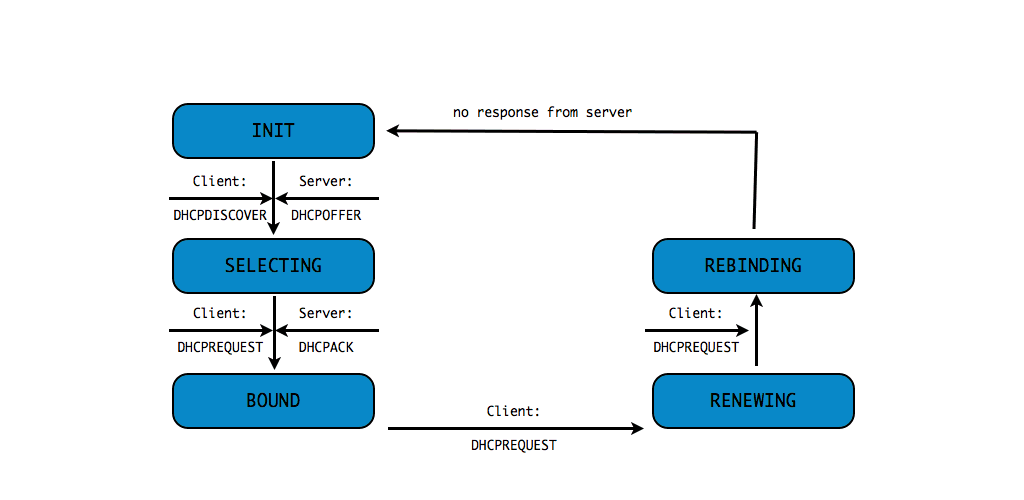
All content © 2020 Internet Systems Consortium, Inc.


with IPv4 address (1/4)
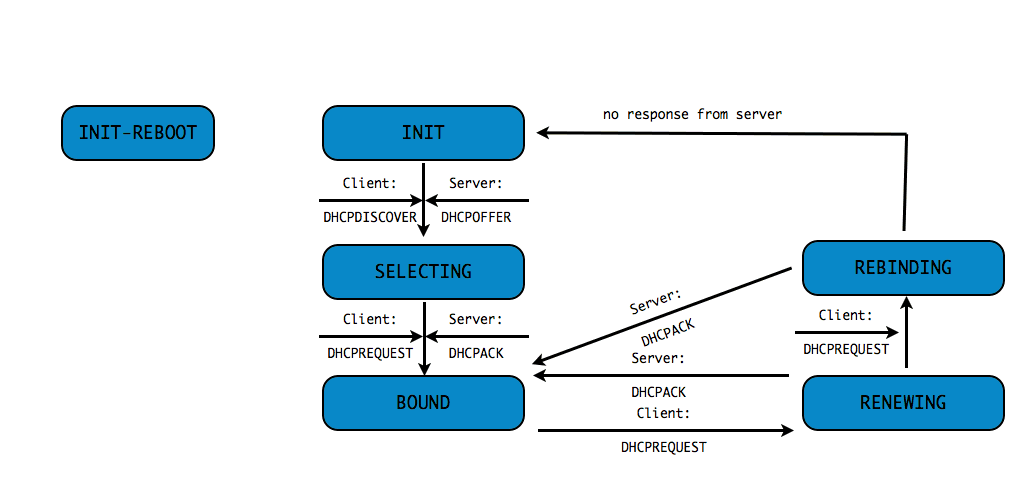
All content © 2020 Internet Systems Consortium, Inc.


with IPv4 address (2/4)
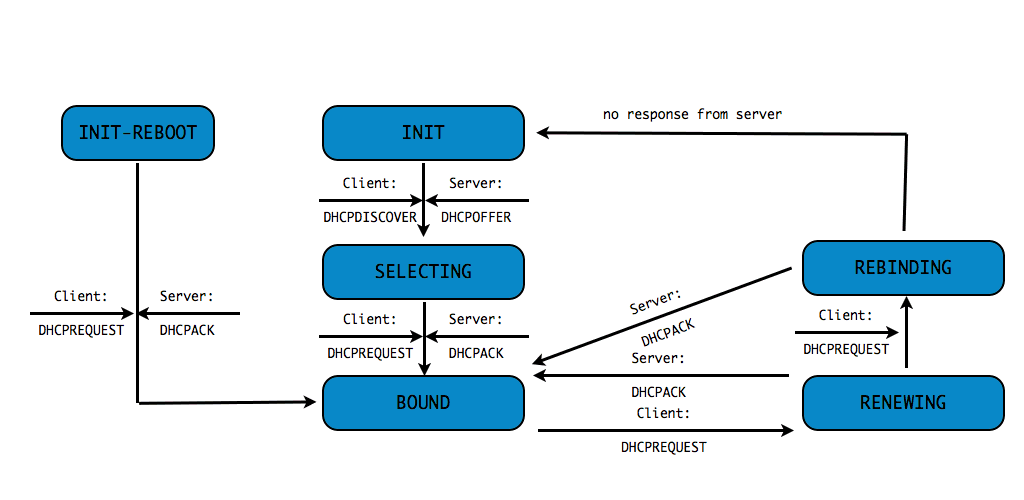
All content © 2020 Internet Systems Consortium, Inc.


with IPv4 address (3/4)
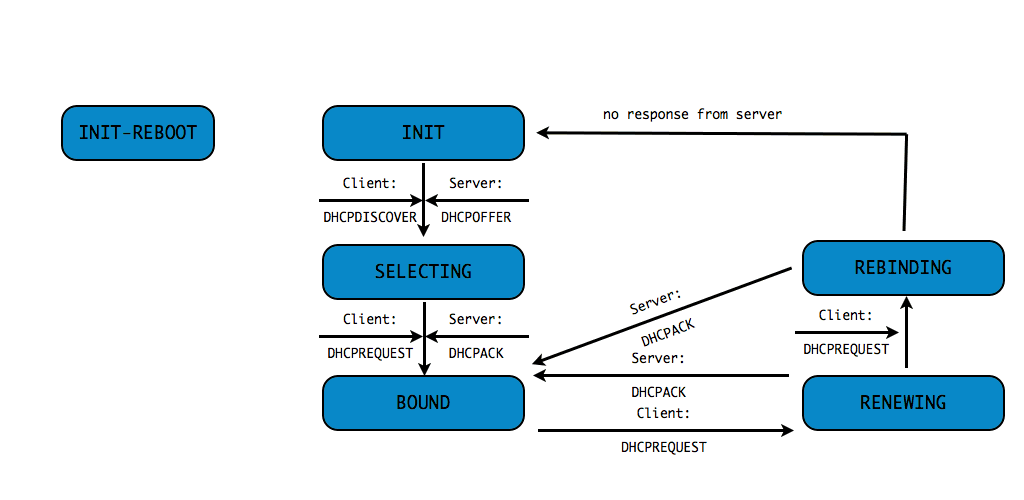
All content © 2020 Internet Systems Consortium, Inc.


with IPv4 address (4/4)
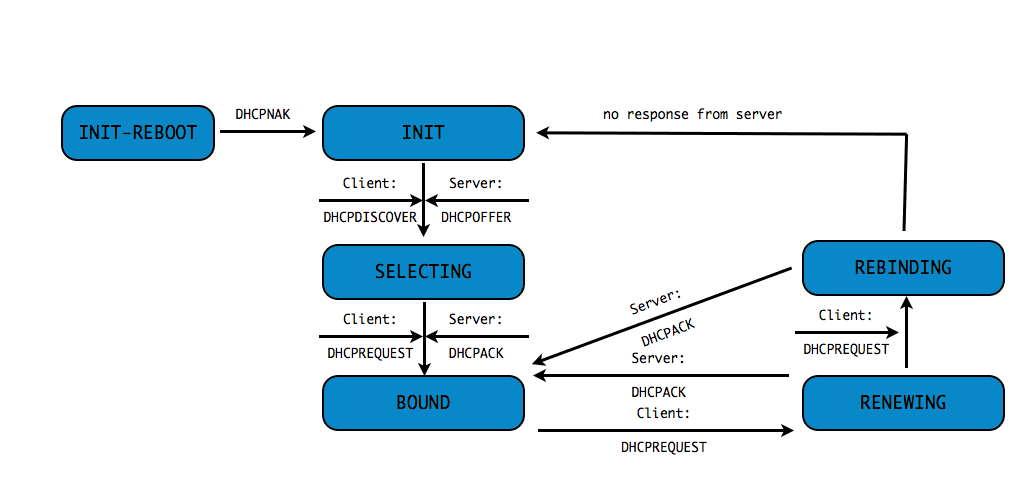
All content © 2020 Internet Systems Consortium, Inc.


distributing network configuration with DHCP
All content © 2020 Internet Systems Consortium, Inc.


BOOTP fields and DHCPv4 Options
- in addition to an IP address, DHCPv4 can be used to network
configuration to a client
- BOOTP configuration fields like
next-serverorboot-file-name - DHCPv4 options like
domain-name-serversordomain-search
- BOOTP configuration fields like
- we will cover the BOOTP fields and DHCPv4 options in our next webinar
All content © 2020 Internet Systems Consortium, Inc.


Host reservations
All content © 2020 Internet Systems Consortium, Inc.


Host reservation (1/3)
- sometimes a DHCP IP address should always be given to the same
DHCP client machine
- for example if that machine receives incoming connections (web-server, printer, database)
- or if firewall rules define a security policy based on the IP address
- A host reservation binds a DHCP client via a client identifier (Ethernet MAC address) to an IP address
All content © 2020 Internet Systems Consortium, Inc.


Host reservation (2/3)
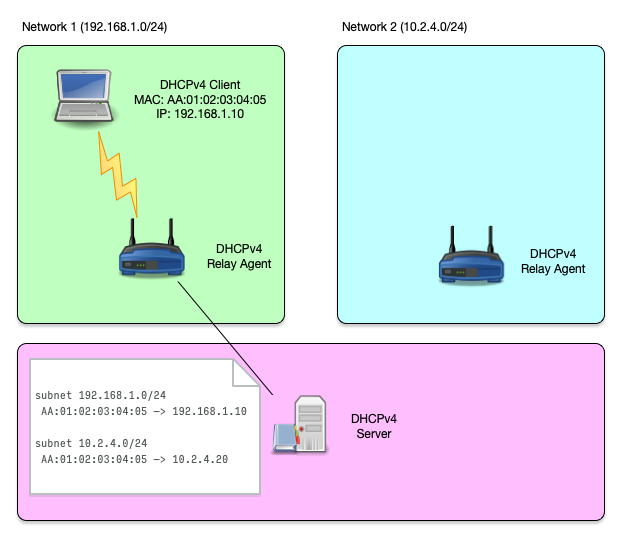
All content © 2020 Internet Systems Consortium, Inc.


Host reservation (3/3)
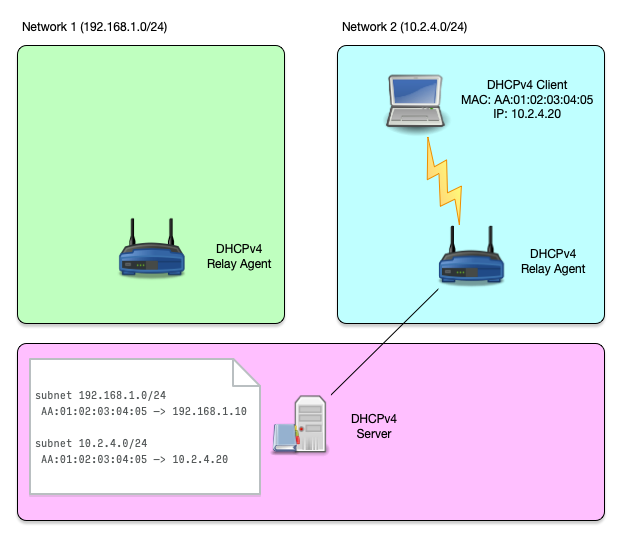
All content © 2020 Internet Systems Consortium, Inc.


Shared Subnet
All content © 2020 Internet Systems Consortium, Inc.


Shared Subnet (1/8)
- A shared subnet is a physical network with more than one DHCPv4 managed subnet inside
- shared subnet are sometimes created if a larger number of IP addresses are needed in a network, but because of IPv4 address shortage no continuous range of IPv4 addresses are available
All content © 2020 Internet Systems Consortium, Inc.


Shared Subnet (2/8)
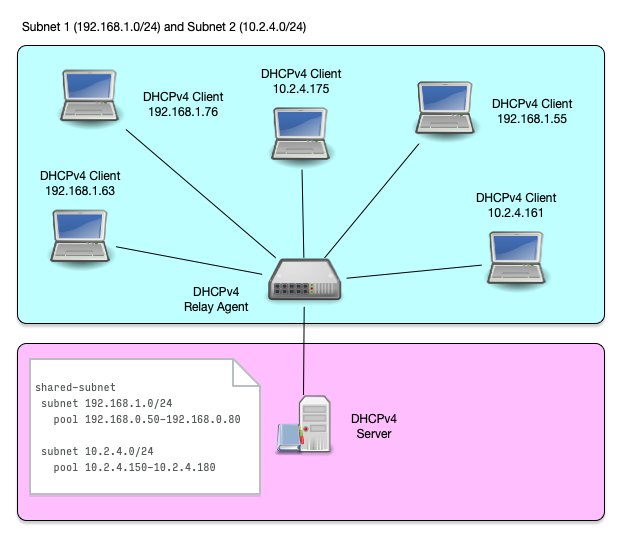
All content © 2020 Internet Systems Consortium, Inc.


Shared Subnet (3/8)
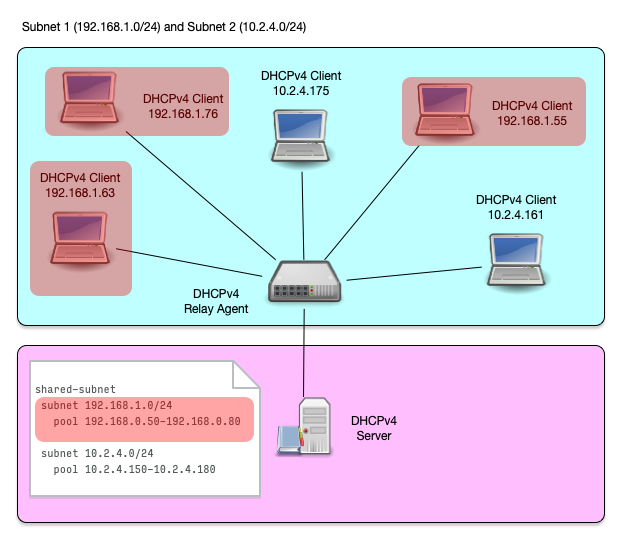
All content © 2020 Internet Systems Consortium, Inc.


Shared Subnet (4/8)
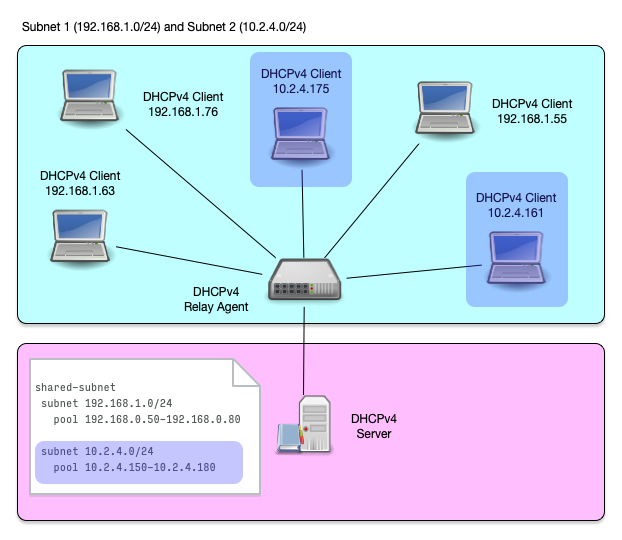
All content © 2020 Internet Systems Consortium, Inc.


Shared Subnet (5/8)
- another use case of shared subnets is a network where addresses
from different IPv4 subnets (and possibly different network
configuration) should be given to different network devices
- cable modems and end user devices
- printer, desktop and mobile devices
- POS terminals and retail infrastructure devices (digital price tags)
All content © 2020 Internet Systems Consortium, Inc.


Shared Subnet (6/8)
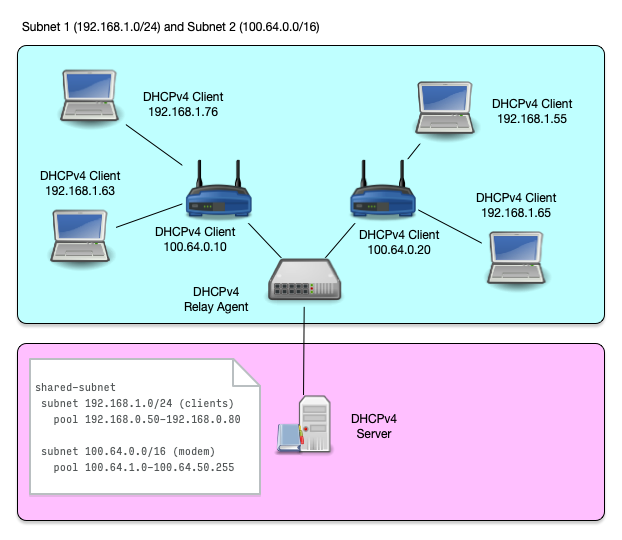
All content © 2020 Internet Systems Consortium, Inc.


Shared Subnet (7/8)
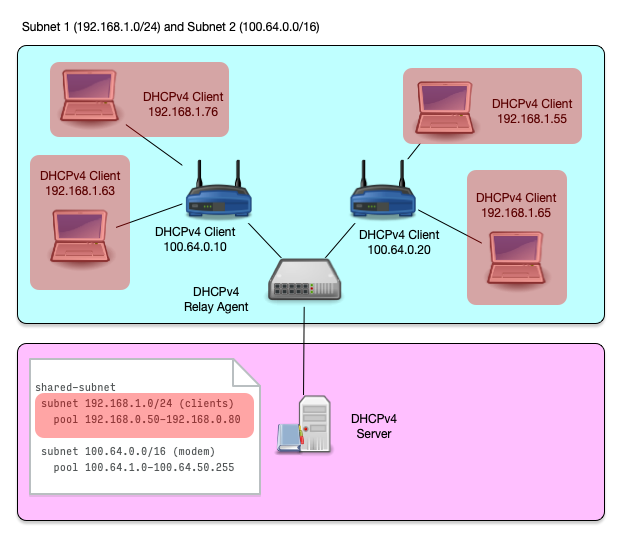
All content © 2020 Internet Systems Consortium, Inc.


Shared Subnet (8/8)
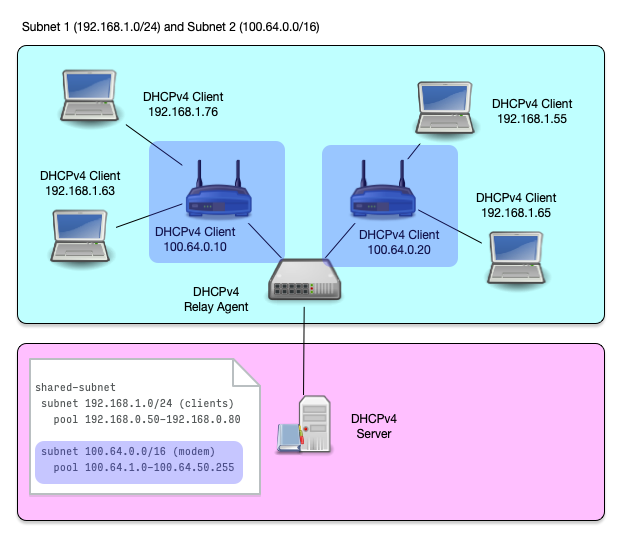
All content © 2020 Internet Systems Consortium, Inc.


DHCPv6
All content © 2020 Internet Systems Consortium, Inc.


DHCPv6
- from a birds-eye view, DHCPv6 works the same way as DHCPv4
- in the details, it is very different
- DHCPv6 is not an upgrade to DHCPv4, it is a protocol of its own
All content © 2020 Internet Systems Consortium, Inc.


DHCPv6 IP based vs. DHCPv4 Layer2/Ethernet based (use of link-local addresses)
- DHCPv6 is solely a Layer 3 protocol
- a DHCPv6 client already has a working link-local IPv6 address
(
fe80::) when sending the first DHCPv6 request - no "low-level kernel trickery" required
- a DHCPv6 client already has a working link-local IPv6 address
(
All content © 2020 Internet Systems Consortium, Inc.


DHCPv6 protocol (port numbers, communication)
- DHCPv6 Servers and Relay-Agents listen on Port
547(UDPv6) - DHCPv6 clients listen on Port
546(UDPv6)
All content © 2020 Internet Systems Consortium, Inc.


DHCPv6 multicast usage and addresses
- DHCPv6 clients communicate using link-local multicast addresses
- All-DHCP-Relay-Agents-and-Servers (
ff02::1:2) - All-DHCP-Servers (
ff05::1:3)
- All-DHCP-Relay-Agents-and-Servers (
All content © 2020 Internet Systems Consortium, Inc.


the role of router in DHCPv6
- DHCPv6 has been designed to provide it's service in cooperation
with the local router(s)
- DHCPv6 must be enabled in the router configuration (
M-FlagorO-Flag) - The Default-Gateway Address will be retrieved from a router and not from the DHCPv6 Server
- DHCPv6 must be enabled in the router configuration (
All content © 2020 Internet Systems Consortium, Inc.


Router and DHCPv6 (1/2)
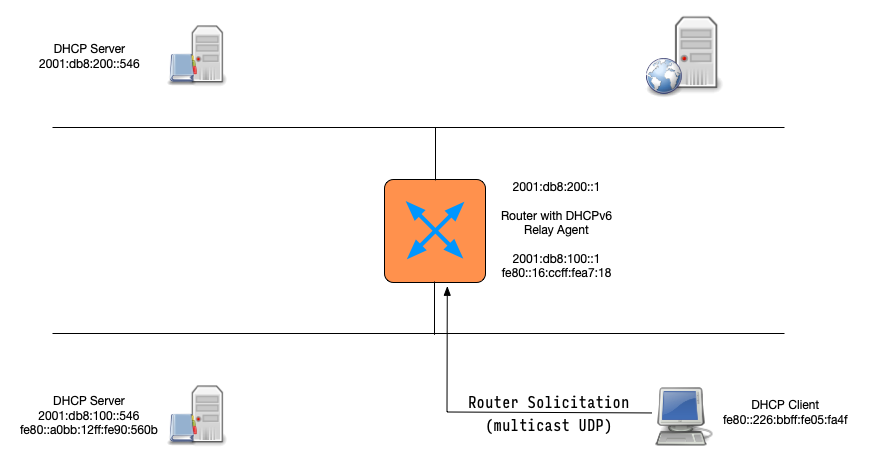
All content © 2020 Internet Systems Consortium, Inc.


Router and DHCPv6 (2/2)
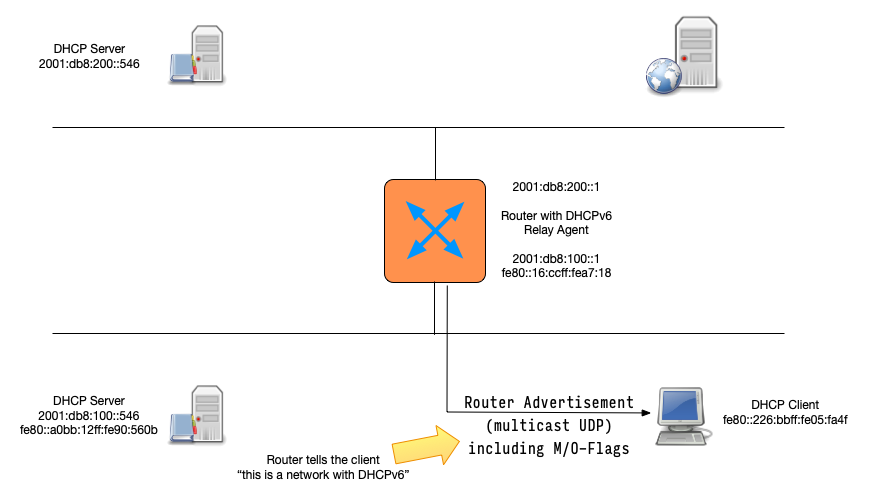
All content © 2020 Internet Systems Consortium, Inc.


DHCPv6 address allocation vs. DHCPv4 address allocation
- DHCPv6 server must issue IP Addresses randomly from the available
address pool
- some DHCPv4 server products issue IP Addresses continuously
- The DHCPv6 scheme makes it harder to guess an IP Address or scan a network segment
All content © 2020 Internet Systems Consortium, Inc.


DHCPv6 allocation types: non-temporary, temporary, multiple addresses, prefix-delegation
- a DHCPv6 client can send different kind of IP address requests
- non-temporary: an address that will always be given to this client if available. This is similar to an DHCPv4 address request.
- temporary: an address that will always change on each request and has a low lease time. Used by the client for outgoing connections for privacy reasons
- multiple: a client can request multiple IP addresses from the DHCPv6 server
- prefix delegation: a client that is a router and also a DHCPv6
server itself can request one or more IPv6 prefix networks from
an upstream DHCPv6 server
- this allows for an hierarchical DHCPv6 configuration
All content © 2020 Internet Systems Consortium, Inc.


DHCPv6 in combination with SLAAC
- IPv6 support Stateless Automatic Address Configuration aka SLAAC
- SLAAC can be used as an alternative to DHCPv6
- SLAAC and DHCPv6 can be combined
All content © 2020 Internet Systems Consortium, Inc.


DHCPv6 - stateless vs. stateful
- There are two different ways to get an IPv6 address for a IPv6 enabled device
- Stateless configuration
- Stateful configuration
All content © 2020 Internet Systems Consortium, Inc.


DHCPv6 - stateless vs. stateful
- Stateless configuration
- The IPv6 address will be determined without a DHCP Server (IPv6 auto-configuration = SLAAC)
- Stateful configuration
- The IPv6 address will be received from a DHCPv6 Server
- In both cases additional configuration parameters (DNS Server etc) can be retrieved by DHCPv6
All content © 2020 Internet Systems Consortium, Inc.


DHCPv6 solicit message
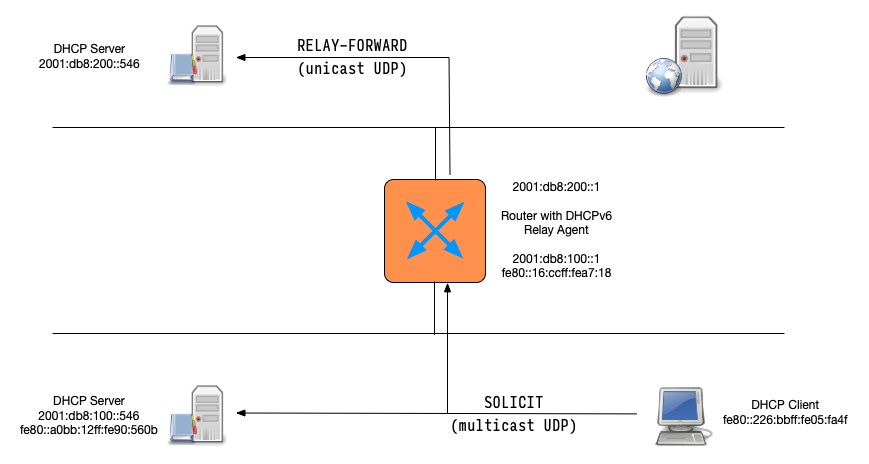
All content © 2020 Internet Systems Consortium, Inc.


DHCPv6 advertise message
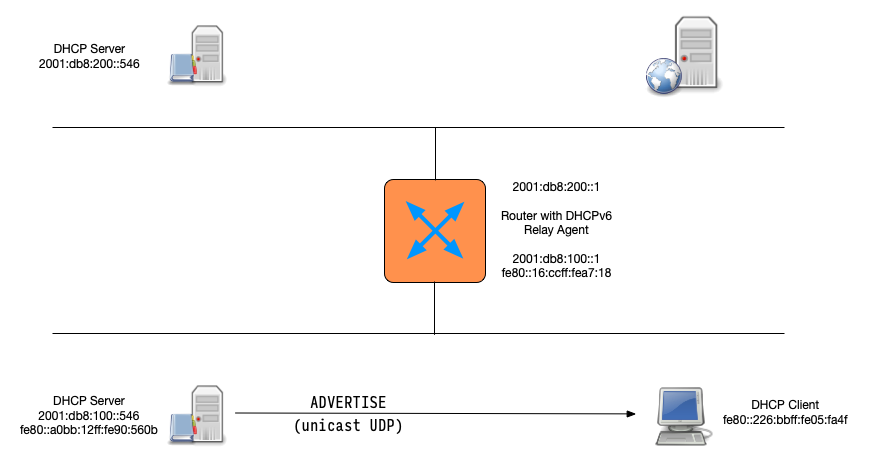
All content © 2020 Internet Systems Consortium, Inc.


DHCPv6 advertise (via relay)
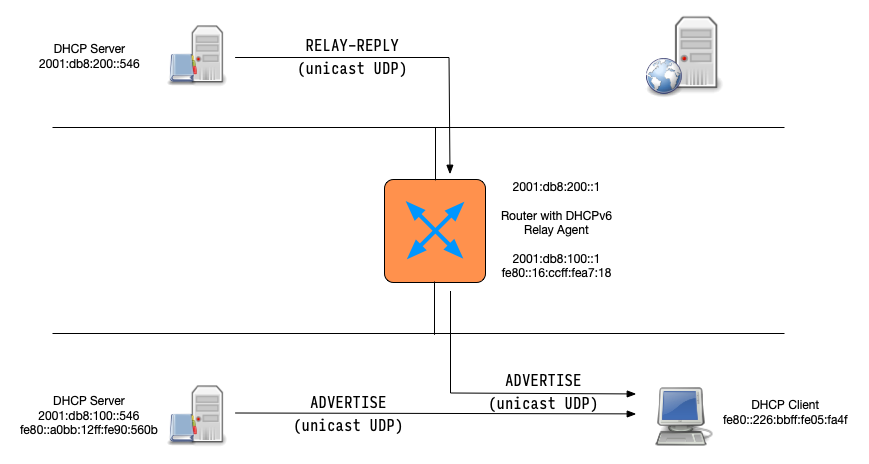
All content © 2020 Internet Systems Consortium, Inc.


DHCPv6 request
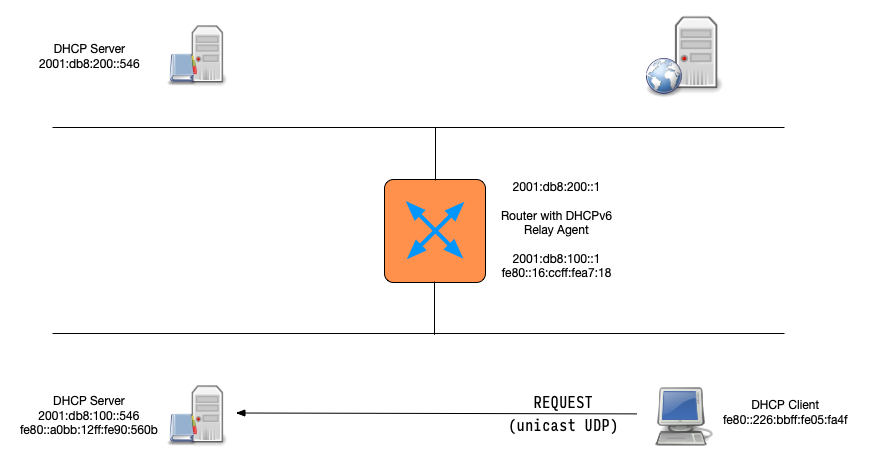
All content © 2020 Internet Systems Consortium, Inc.


DHCPv6 reply
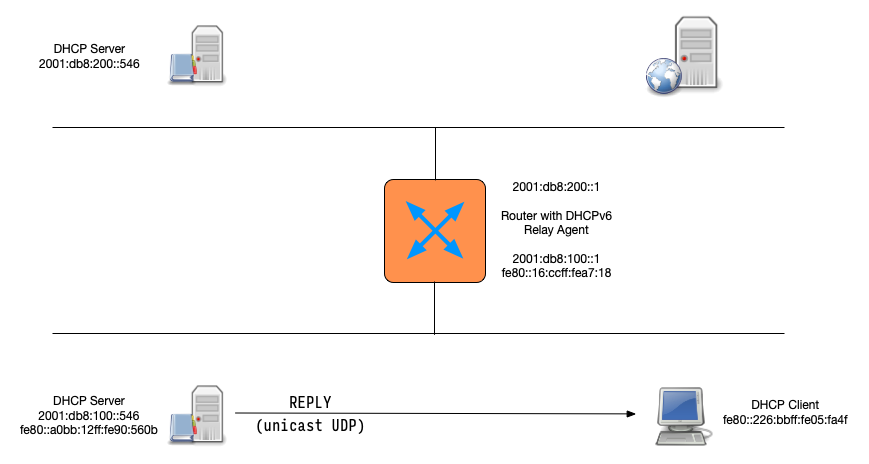
All content © 2020 Internet Systems Consortium, Inc.


DHCPv6 client assigns new IPv6 address
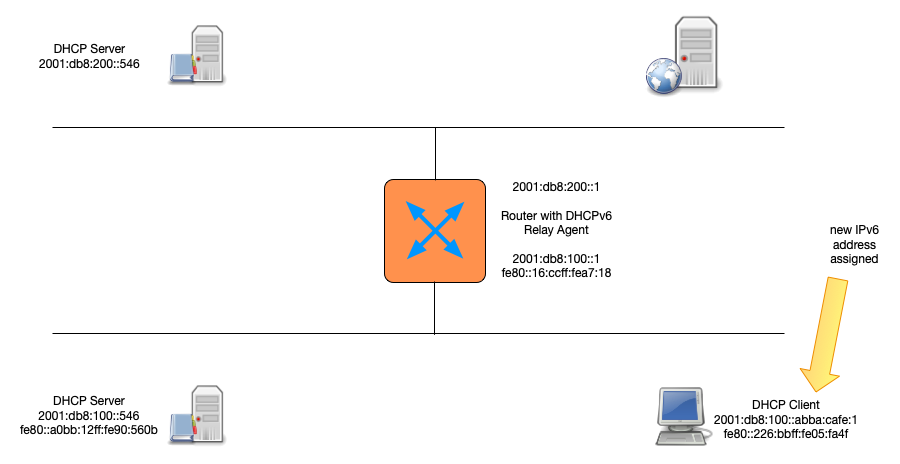
All content © 2020 Internet Systems Consortium, Inc.


Identity Association (IA)
- An Identity Association (IA) is a construct through which a server and a client can identify, group, and manage a set of related IPv6 addresses (or delegated prefixes)
- Each
IAconsists of anIAID(Identity Association ID) and associated configuration information - if a client has more than one network interface, every interface
will be associated with one distinct
IAID
All content © 2020 Internet Systems Consortium, Inc.


Identity Association (IA)
- DHCPv6 clients can receive temporary and non- temporary addresses
- temporary addresses are used for communication with outside, untrusted networks (like the Internet)
- temporary addresses make it difficult to track a client, they are created randomly and change often
- non-temporary addresses are stable and can be used to track a client machine (non-temporary addresses are used in trusted, internal networks)
- temporary and non-temporary (stable) IPv6 addresses are managed with the help of IAIDs
All content © 2020 Internet Systems Consortium, Inc.


DHCPv6 client states (1/8)
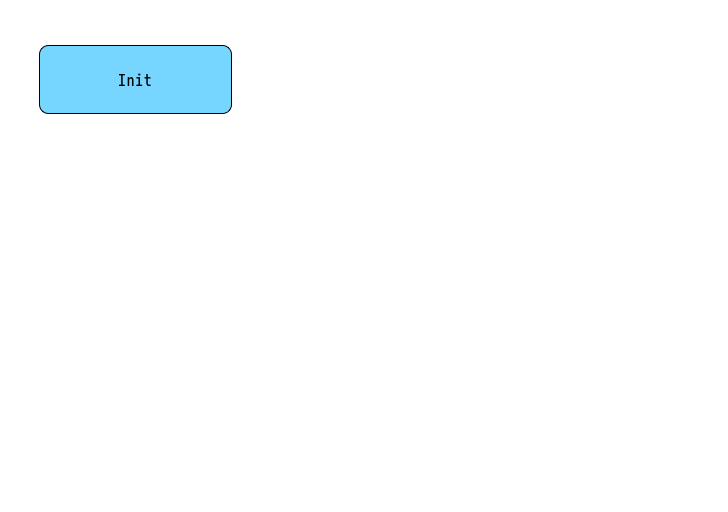
All content © 2020 Internet Systems Consortium, Inc.


DHCPv6 client states (2/8)
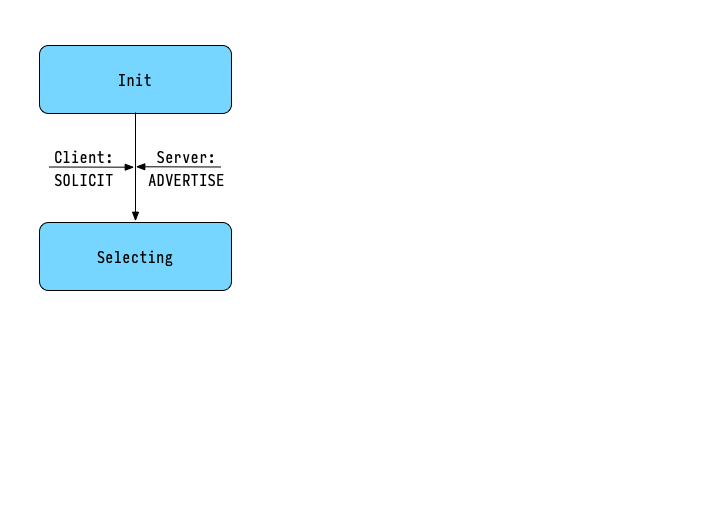
All content © 2020 Internet Systems Consortium, Inc.


DHCPv6 client states (3/8)
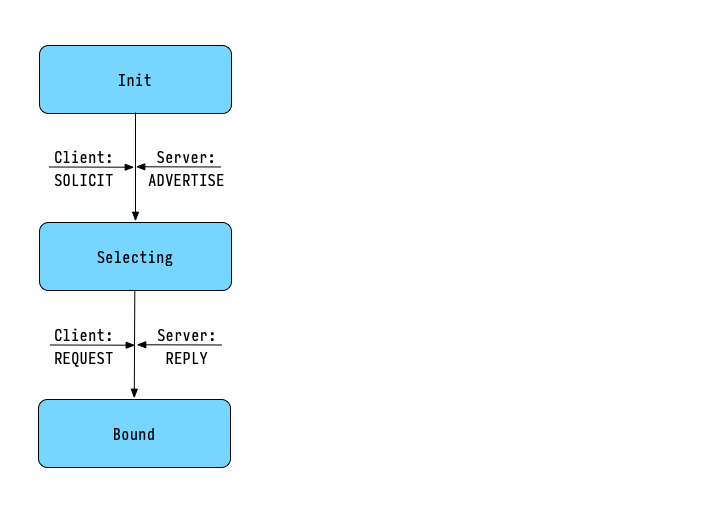
All content © 2020 Internet Systems Consortium, Inc.


DHCPv6 client states (4/8)
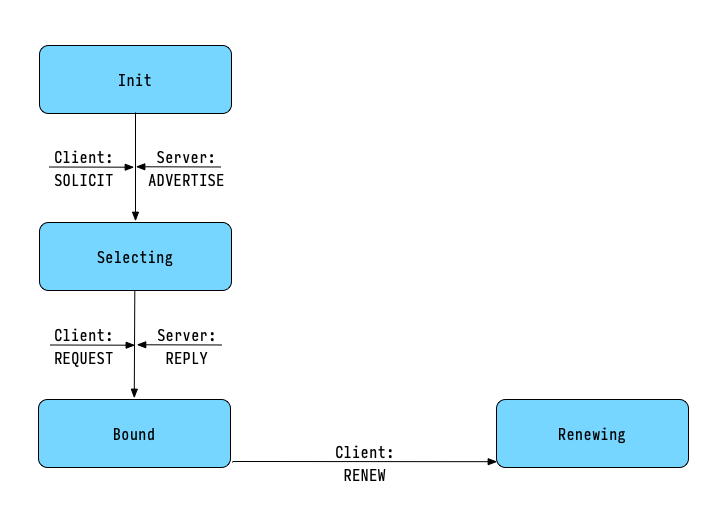
All content © 2020 Internet Systems Consortium, Inc.


DHCPv6 client states (5/8)
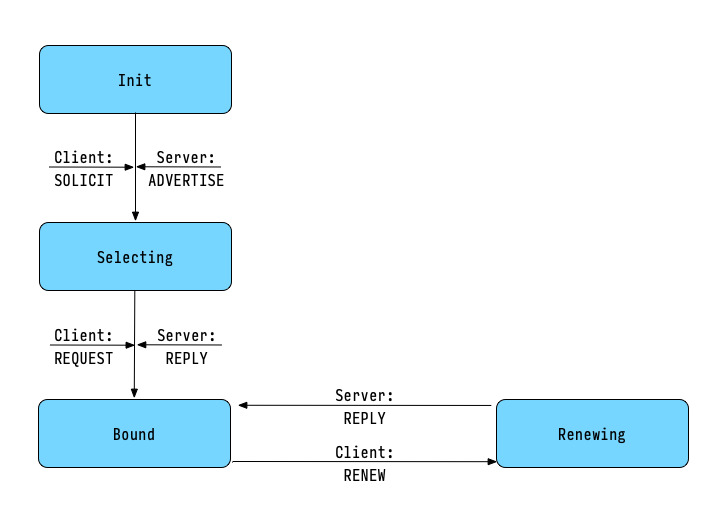
All content © 2020 Internet Systems Consortium, Inc.


DHCPv6 client states (6/8)
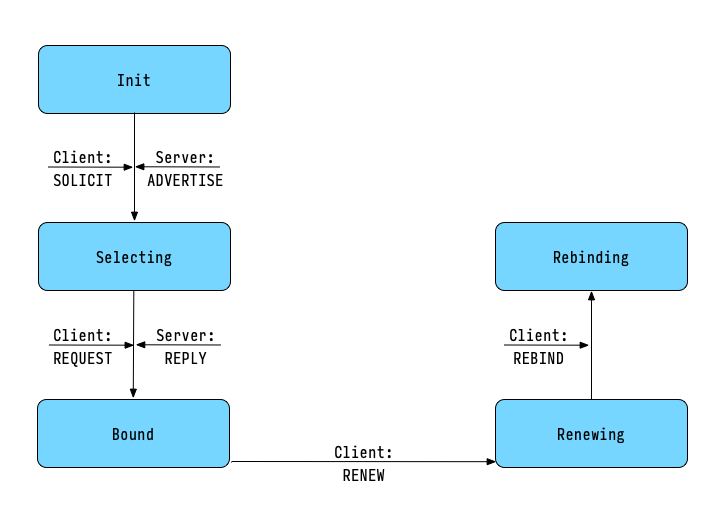
All content © 2020 Internet Systems Consortium, Inc.


DHCPv6 client states (7/8)
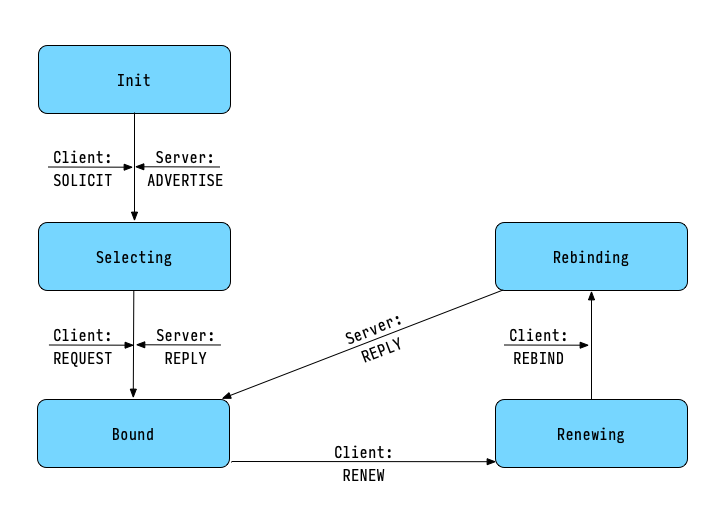
All content © 2020 Internet Systems Consortium, Inc.


DHCPv6 client states (8/8)
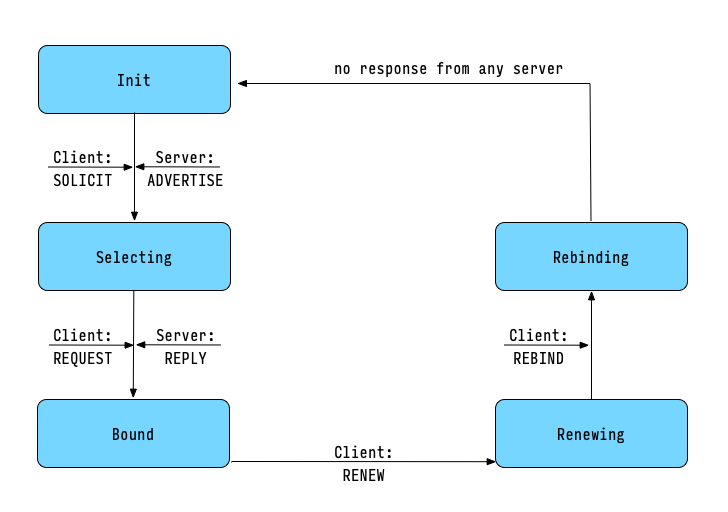
All content © 2020 Internet Systems Consortium, Inc.


DHCPv6 rapid commit
- rapid commit speeds up the process of joining a network (only one packet exchange)
- with rapid commit there is no information send to the DHCPv6 server
telling the server whether the client is using the advertised IPv6 address
- the DHCPv6 server must reserve the IPv6 address for the full lease time
- this (temporary) squandering of IPv6 addresses is usually not a problem because of the large size of IPv6 subnets (/64 prefixes)
- the DHCPv6 server must reserve the IPv6 address for the full lease time
All content © 2020 Internet Systems Consortium, Inc.


DHCPv6 rapid commit
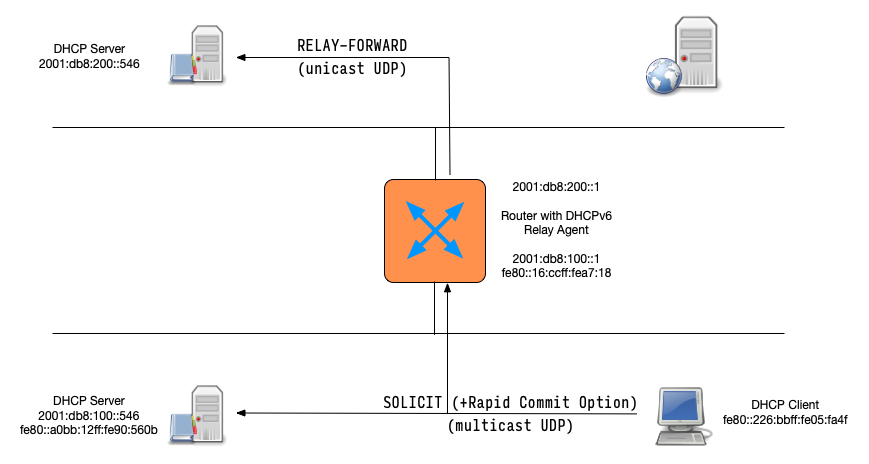
All content © 2020 Internet Systems Consortium, Inc.


DHCPv6 rapid commit
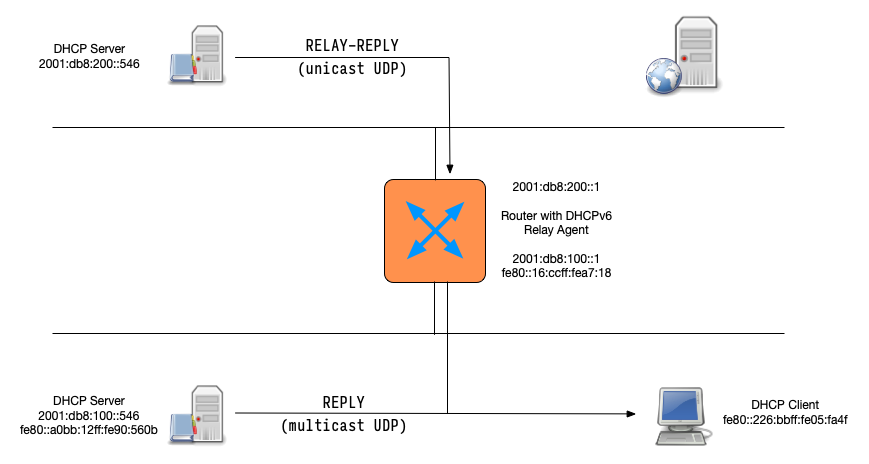
All content © 2020 Internet Systems Consortium, Inc.


DHCPv6 rapid commit
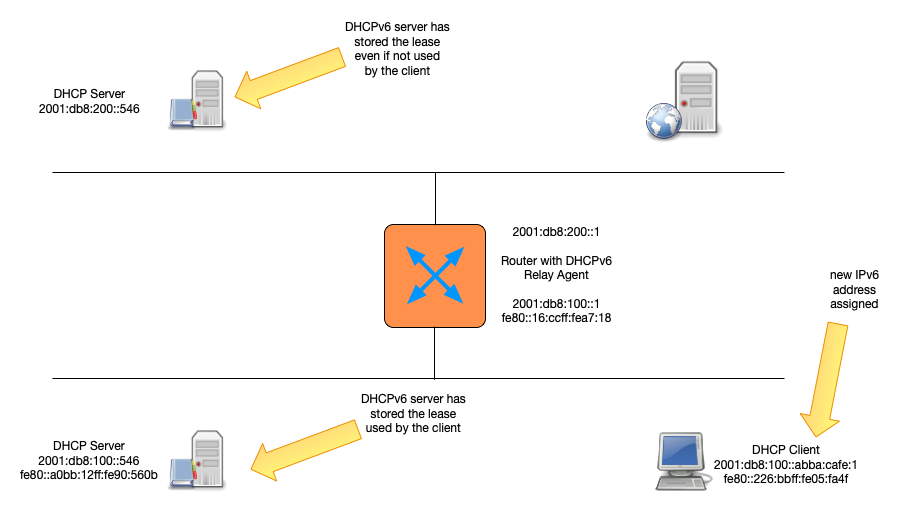
All content © 2020 Internet Systems Consortium, Inc.


References: RFCs, Books, recommended Webpages
All content © 2020 Internet Systems Consortium, Inc.


Internet Standards
- DHCPv4
- RFC 2131 - DHCPv4 Dynamic Host Configuration Protocol
- RFC 2132 - DHCP Options and BOOTP Vendor Extensions
- RFC 3396 - Encoding Long Options in the Dynamic Host Configuration Protocol (DHCPv4)
- RFC 4361 - Node-specific Client Identifiers for Dynamic Host Configuration Protocol Version Four (DHCPv4)
- RFC 6842 - Client Identifier Option in DHCP Server Replies
- DHCPv6
All content © 2020 Internet Systems Consortium, Inc.


Books
- The DHCP Handbook - Understanding, Deploying, and Managing Automated Configuration Services (Ralph Droms, Ted Lemon) 1999
- IP Address Management - Principles and Practice (Timothy Rooney) 2011
- The TCP/IP Guide - A Comprehensive, Illustrated Internet Protocols Reference (Charles M. Kozierok) 2005
- Windows Server 2019 Inside Out (Orin Thomas)
All content © 2020 Internet Systems Consortium, Inc.


Websites
- ISC Kea Documentation - https://kea.readthedocs.io/en/latest/
- ISC Knowledgebase - https://kb.isc.org/
- The TCP Guide - http://www.tcpipguide.com/
- Microsoft - Dynamic Host Configuration Protocol (DHCP) https://docs.microsoft.com/en-us/windows-server/networking/technologies/dhcp/dhcp-top
All content © 2020 Internet Systems Consortium, Inc.


Next Webinars
- 30th September - Kea DHCP - Installation and configuration
- 14th October - Kea DHCP - Lease allocation, client classification, and option assignment
- 28th October - Kea DHCP - High Availability and Database Backends
- 18th November - Kea DHCP - Monitoring, Logging, and Stork
- 2nd December - Kea DHCP - Migrating to Kea from ISC DHCP
All content © 2020 Internet Systems Consortium, Inc.


Questions and Answers
All content © 2020 Internet Systems Consortium, Inc.
